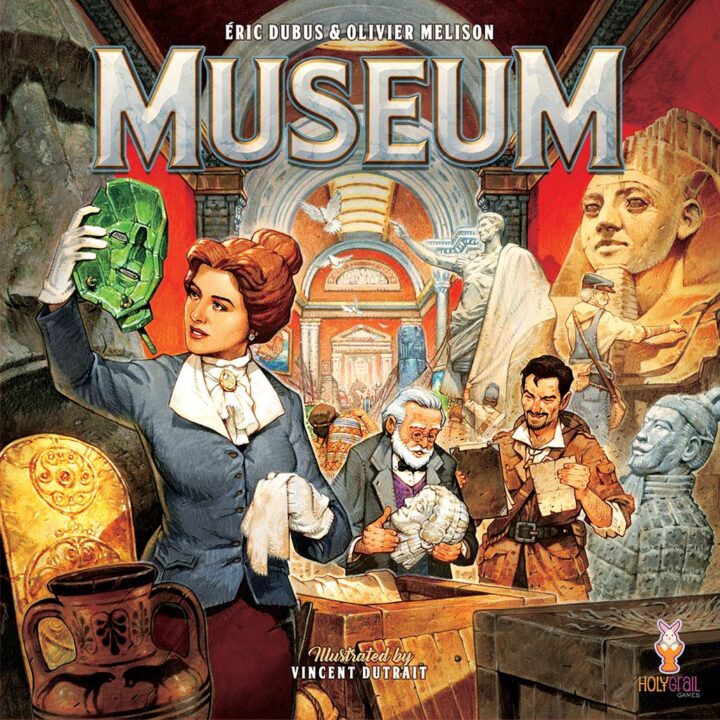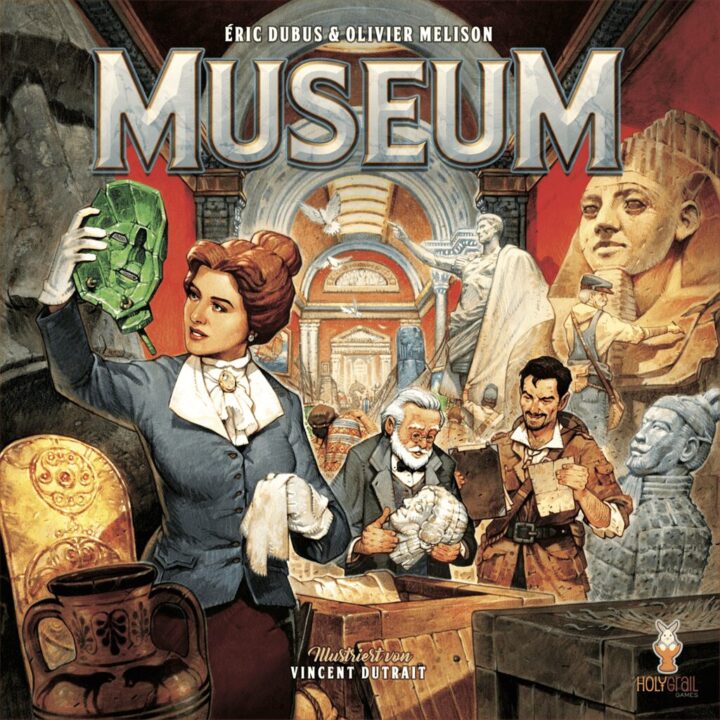Every now and then, a fancy box lands on my table, promising wonders and a mess of tokens. This is one of those times! Welcome to my review of Museum. I’ve wrestled with its cards, squinted at its art, and even (accidentally) flipped the board during a heated debate over artifacts. If you’re wondering if this game deserves space on your shelf, fear not: I’ve suffered, laughed, and maybe cried a little so you don’t have to. Let’s see if collecting relics is as fun as it sounds—or if your friends will hunt you down after stealing their precious artifacts (speaking from experience).
How It Plays
Setting up
Shuffle the artifact cards and give each player a museum board and Reference sheet. Place the main board in the middle. Lay out the public objectives and give everyone a starting hand of cards. Now, build your hopes, dreams, and a pile of discarded wrappers from opening the box.
Gameplay
On your turn, you collect artifacts from the same continent or era. You can trade cards with rivals (who are only nice when it’s in their favor), and add items into your museum to start collections. Complete objectives, try to keep your museum neat (just like my childhood room… aka pure chaos), and watch out for the Public Opinion track or you’ll lose points for looking like a Victorian hoarder.
Winning the game
Once the artifact deck runs out, start the final round. Everyone counts their points from their displayed collections, objectives, and bonuses. Highest score wins and gets the bragging rights of being the world’s most accomplished curator. If you lose, claim your museum was just avant-garde.
Want to know more? Read our extensive strategy guide for Museum.
Set Collection: The Real Meat and Potatoes of Museum
If you’re anything like me, you love the thrill of hoarding shiny things. Museum’s set collection gameplay feeds this urge in a big way. The whole game centers around gathering artifacts (yep, that’s your precious loot) from all corners of the globe. But it’s not just about grabbing anything and everything—you’ve got to grab the right stuff at the right time. It’s like grocery shopping for a picky grandparent who only eats food from the 1800s.
Here’s where the tension creeps in and keeps everyone on the edge of their seats. Every card you collect could help you or…help someone else even more. The public objectives and set bonuses dangle in front of you like a carrot you can almost, but not quite, reach. I’ve seen my buddy shriek (yes, shriek) when someone nabbed the last artifact he needed for a complete collection. My group often ends up in heated debates over who is sabotaging who, and let’s just say friendships have been stress tested with this game.
Museum keeps you feeling clever, until you realize someone else pulled off a better combo under your nose. There’s constant pressure to adapt your set-collecting plans, as the market of available cards shifts with every turn. If you plan too slow, your opponents will gobble up the good stuff, but if you rush, you may be stuck with leftovers nobody wants. For set collection fans, this is a regular tension buffet with anxiety sprinkles on top. But when everything falls into place and you finish a tricky collection, it feels amazing—like finding a fiver in your old coat.
But hey, let’s put the cards down for a sec, because up next I’m spilling the beans on Museum’s art and components. Spoiler: they’re almost as pretty as my collection of novelty mugs.

Art and Component Quality: Beauty in Museum’s Halls
I have a soft spot for great art in board games, and Museum might as well be the art snob’s dream come true. The moment I opened the box, I wondered if I should wear white gloves. Every card in Museum showcases an artifact or ancient relic, drawn with loving detail and colors that pop. I swear, if these cards were just a bit bigger, I’d hang them on my wall. There are even little flavor texts on many cards, so you’ll feel like you’ve learned something by accident. My friend Sam named his museum ‘The Place With All The Pretty Stuff’, and for once, I couldn’t argue with him.
The main board looks like the sort of thing some hip museum café would use as a placemat. The iconography is clear, which means less time squinting and more time arguing with your friends about whether a Roman coin or a Viking axe would make a better centerpiece. The player boards are sturdy, though I wish they had a tiny bit more space. Things get crowded when you’re on a hoarding spree—yes, I’m guilty. The tokens and cards are high quality, and nothing in our several plays felt cheap or flimsy. Even after one game where I accidentally spilled a soda (sorry, Sam), the cards survived, though they now smell faintly of cola.
Overall, Museum’s component quality holds up, both for the eyes and the hands. Next up, let’s talk about how Museum turns friends into rivals, as we explore player interaction and strategy. Bring your best poker face!

Player Interaction and Strategy Balance in Museum: Trading, Timing, and Tactical Twists
If you ask my friends (and please don’t, they love to exaggerate), I’m a sucker for games that make you stare at each other across the table like poker pros. Museum does this very thing, and it does it without flipping tables—well, almost. The key is the trading mechanic. On your turn, you can offer cards from your hand for trade, trying to tempt others to help you complete your masterpieces—or maybe trick them into helping you when you’re actually helping yourself. In our group, this led to some wild negotiations and a few “I’ll trade you for pizza next game night” offers.
Balance-wise, Museum feels fair most of the time, though it does reward folks who count cards and keep tabs on which civilizations are still out there. You need a sharp eye and a sharper memory, or at least a friend with both. The strategy comes from collecting sets for your museum, fulfilling public objectives, and knowing when to let go of a card that’s tempting but just doesn’t fit your big plan. It’s not easy—you’ll second-guess yourself. There are enough paths to victory that nobody felt locked out, even when I, with my classic overconfidence, was sure I had the win by round three (spoiler: I did not).
What I liked most is that the player interaction never felt mean-spirited, and there was always a sense of agency—no one sat around twiddling their thumbs. Everyone had skin in the game, thanks to those tense card trades and timing decisions. Next up, I’ll tell you how many times we brought this box back to the table and whether it’s worth making room for every expansion—stay tuned for the replayability rollercoaster and expansion bonanza!
Replayability and Expansion Potential: Will Museum Stay Interesting?
If there’s one thing my gaming group is good at, besides arguing over the last slice of pizza, it’s burning through games until the magic wears off. But let me tell you, Museum has some serious staying power. After more plays than I care to admit (yes, my friends are now experts in ancient pottery), the game still throws up new combos and tricky choices every time. That huge deck of cards means you won’t see the same artifacts in every game, so strategies have to change depending on what comes up. It keeps us on our toes. No stale routine, just pure, unfiltered nerd joy.
Now, let’s talk expansions, because Museum has options! If you get tired of the base game—and I haven’t, but maybe you’re a fiend for variety—there’s a decent set of expansions that add new mechanics and artifacts. I tried “The Cthulhu Mythos” expansion, and nothing says ‘family fun’ like eldritch horrors in the gallery. Each expansion seems to blend in well, adding just enough spice to keep things fresh, without turning the game into an overcooked mess. The designers really made sure that expansions aren’t just cash grabs (thank goodness).
So, do I recommend Museum? If you like changing strategies and want a game you can come back to without yawning, absolutely. Just remember to clear off a big table and maybe guard your snacks from greedy hands. Museum earns my nerdy seal of approval for replayability!
Conclusion
Alright, that’s my full review—if you’re still with me, either you love museums or you’re just really bored! Museum is a proper beauty with awesome art and tough choices. It has strategy, player trading, and enough replay value so your shelf won’t gather dust. A few rules can get fiddly and luck sometimes sticks its nose in, but it’s still miles ahead of most set collection games. Expansions add a good bit of spice too. If you want something that feels clever but not mean, and you enjoy making your friends jealous of your ancient Greek vase collection, Museum is an easy recommendation. Thanks for reading and remember: don’t touch the artifacts with greasy hands!

